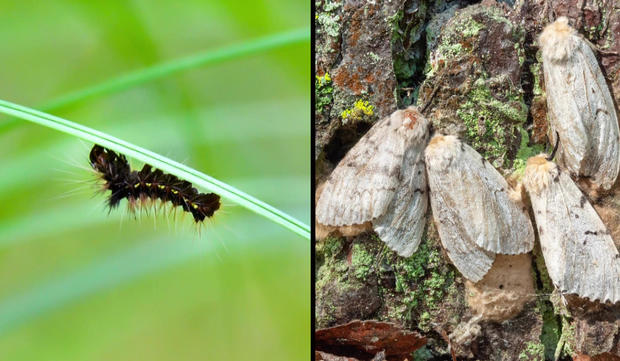The government says to destroy these invasive, fuzzy mud-looking masses. Here's why.
The Department of Agriculture is seeking the public's help to destroy an invasive species that looks like spongy mud and is growing outdoors. With spring's official arrival, the agency says "smashing and scraping" will be an essential tool in keeping problems at bay.
So, what exactly are we on a quest to destroy? Eggs – huge masses of them that look like mud.
In a notice sent out earlier this month, the USDA said that the eggs belong to two invasive species, the spotted lanternfly and spongy moth. Their eggs are laid in masses on cars, trees and other outdoor surfaces, the agency said, recommending that people smash and scrape the masses into a plastic bag that's then sealed and disposed of in the trash. They can also be removed with a pressure washer.
"The spotted lanternfly and spongy moth are economically and environmentally destructive invasive insects," according to the USDA. "Together, they attack or defoliate hundreds of tree and plant species."
The two species contribute to $40 billion in damages every year across crops, trees and other plants, said Kathryn Bronsky, national policy manager for the spongy moth at the USDA's Animal and Plant Health Inspection Service.
Spotted lanternflies and spongy moth eggs are "able hitchhikers" that often go unnoticed on modes of transportation, the USDA added. With lanternflies already existing in 17 states and spongy moths in 20, the agency stressed the importance of keeping an eye out for their offspring.
What do spotted lanternfly and spongy moth eggs look like?
The USDA says that spotted lanternfly egg masses are "flat" and "mud-like," and can have between 30 and 50 eggs. Masses belonging to spongy moths are "fuzzy, spongy and cream or brown-colored" and each one "can hatch up to a thousand tiny caterpillars with a ravenous appetite for leaves," according to the agency, and moth masses also often have a "hair-like covering" that the females lay on top to help protect the eggs.
How to get rid of lanternfly and spongy moth eggs
The USDA encourages a "smash and scrape" method for both invasive species, which can be done in the late fall, winter and early spring. Those who live in quarantine areas for either of the insects will have specific guidance posted by the state's department of agriculture. Others should check all outdoor belongings, especially if they are planning on moving items, including vehicles.






